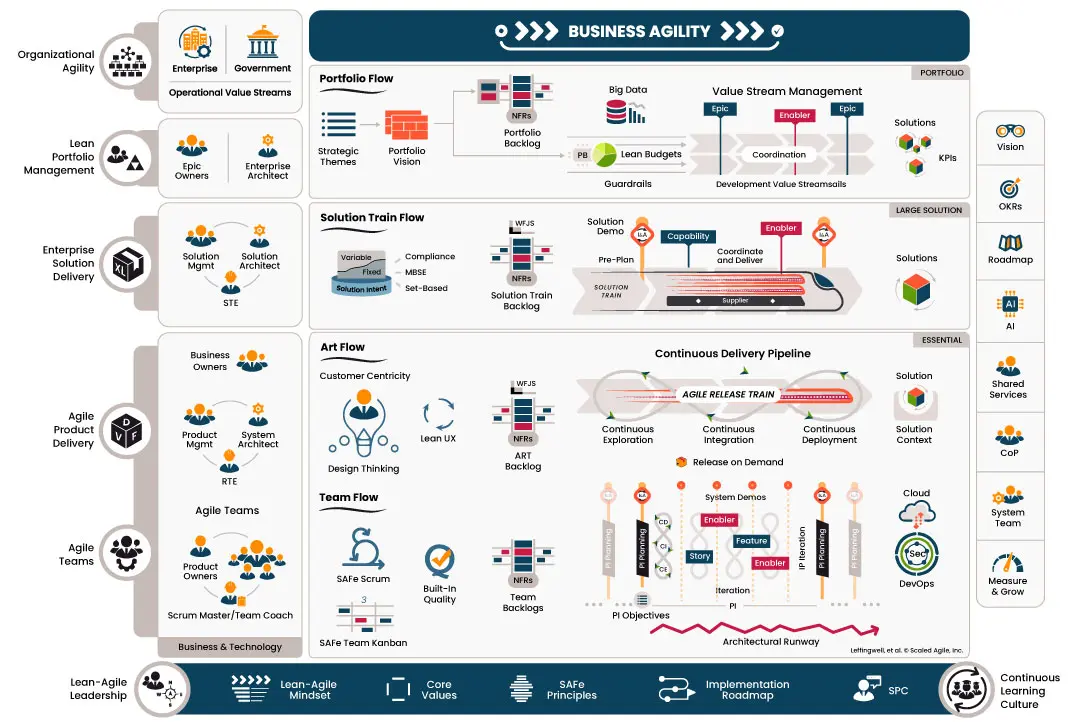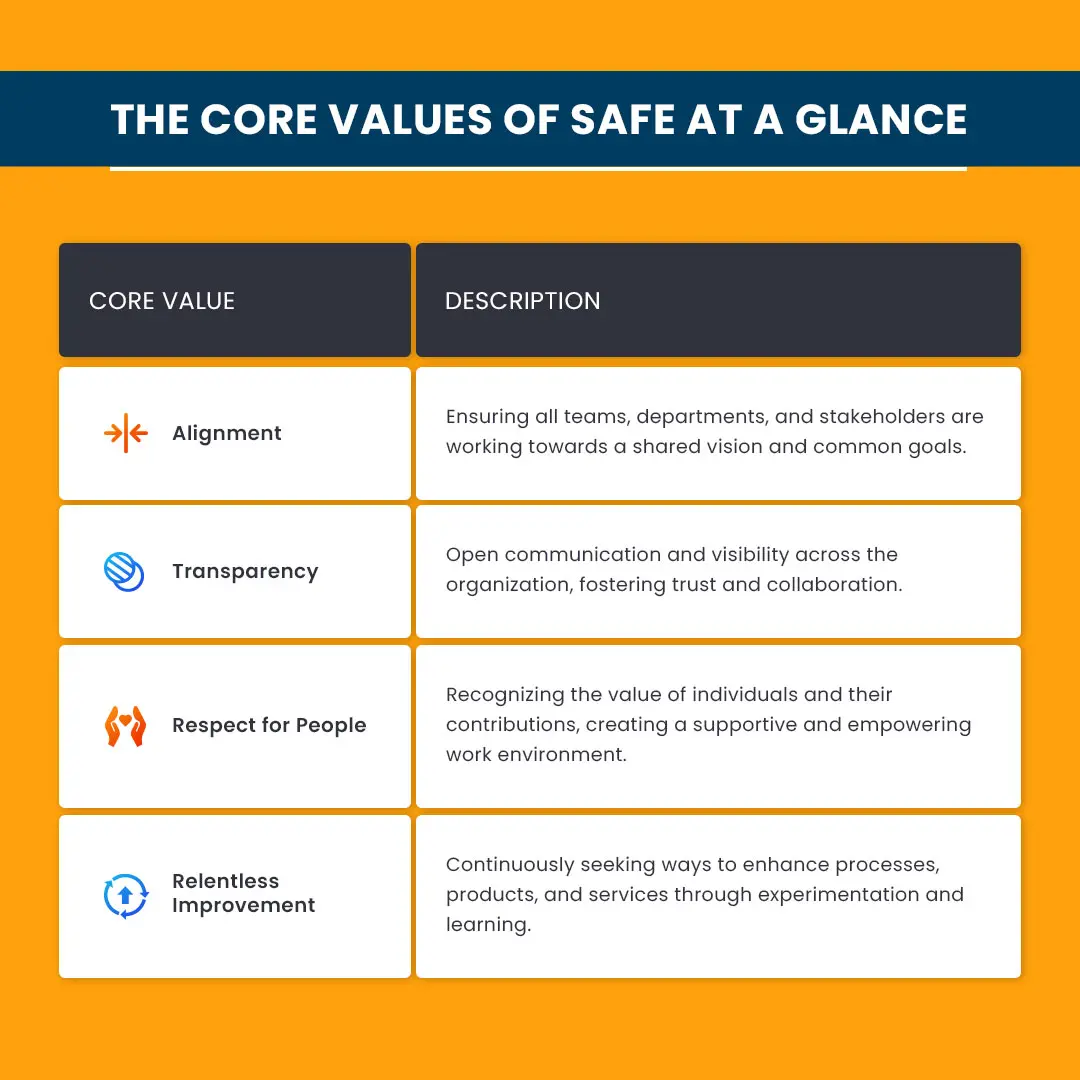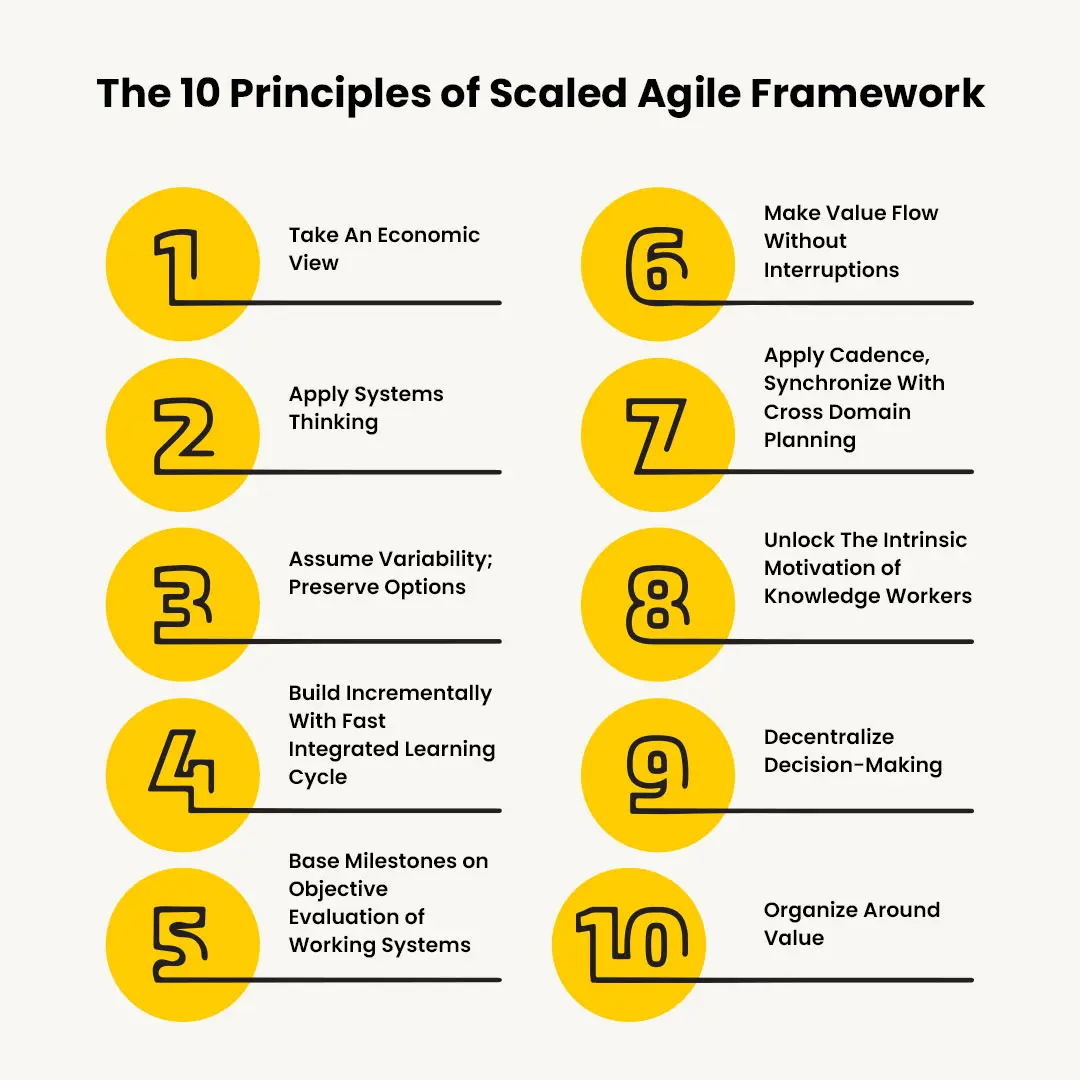It is easier to implement Agile practices across smaller teams. But when it comes to scaling Agile practices across bigger enterprises, it becomes a challenging task. This is because the original Agile methodology is not designed to transform large-scale operations. In 2011, Dean Leffingwell and Drew Jemillo introduced the Scaled Agile Framework as an answer to the challenges of scaling Agile for businesses. The framework, based on the original Agile methodology, is designed to help organizations leverage Agile practices for large-scale business operations.
The SAFe framework has now become the most popular framework for businesses to align teams, programs, and portfolios under Agile principles. It offers clear values and guiding principles and helps enterprises achieve agility across the organization.
SAFe Implementation can help you foster better collaboration among cross-functional teams, speed up innovation, and accelerate the ability to deliver value. The structured method and niche configurations can support your business as it grows and maintain business agility to fuel success.
Let’s take a closer look at the Scaled Agile framework, how it functions, its essential elements, and how it can benefit your business.
A Closer Look at How The SAFe Framework Functions
Built atop the tried and tested sets of organizational and workflow patterns, SAFe offers a structured approach for scaling Agile practices across your organization. It serves as a pillar of knowledge that includes comprehensive guidance on how to plan and manage business operations, new roles and responsibilities that need to be established, and what values your organization must uphold during and after the Agile transformation.

Here’s a comprehensive breakdown of how SAFe framework functions:
Strategic Alignment
SAFe implementation helps you ensure that everyone in your organization, from the C-suite leadership to individual teams, is aligned with the same business goals and strategies. With tools like Portfolio vision and Strategy documentation, you can define the long-term goals, guiding the decision-making process at all levels. The framework helps cross-functional teams to align and focus on how value flows through the organization, and quickly identify and remove roadblocks to ensure things are running smoothly.
Program Increment Planning (PI)
A big part of scaling Agile practices with SAFe is program increment planning. Under this framework, teams at your organization must come together to do a check-in on the “big picture”. This includes principles and priorities alignment, ensuring everyone knows what’s on the table for the next development cycle, and committing to deliver continuous value to the user.
Continuous Delivery
The Scaled Agile Framework significantly emphasizes delivering value continuously via usable products, features, and updates. This helps your organization maintain business agility and deliver valuable experience to your customers regularly, without them having to wait too long for a big update or feature rollout.
Inspect and Adapt
Adopting the SAFe framework allows you to encourage a mindset of constant improvement across your organization. Your teams can regularly pause and inspect their work, learn from mistakes, and realign their approach with newly learned lessons. This approach helps your organization maintain business agility, regardless of the increasing complexity of operations.
Governance and coordination
With the scaled Agile framework, governance is not about tons of documentation and updates that slow things down. Agile project management promotes self-governance among the cross-functional teams to ensure stakeholders working on development projects take ownership of their work. Similarly, governance and coordination in SAFe is all about ensuring different teams within the organizations are aligned and have the right feedback processes in place without affecting innovation.
Scaled Agile Framework: Core Values
SAFe is built on four core values that serve as the four pillars of the framework. Upholding the core values is essential for you to successfully implement Agile at scale across your organization. These values help foster a culture of agility, collaboration, and sustainable growth.

Let’s break them down to see what they mean:
Alignment
Alignment is the cornerstone of the Scaled Agile Framework, preventing the possibility of chaos when scaling Agile practices across large enterprises. When you implement Lean-Agile methods across your business, you essentially empower dynamic teams to make decisions about their own tasks and deliverables. This, however, can lead to challenges if the teams are not aligned with each other and the company's overall vision, mission, and strategy. This first core value of SAFe ensures that everyone, from higher management to the smallest teams is on the same page, accelerating value delivery and maintaining high quality.
Transparency
The second most important core value of SAFe implementation is Transparency. Developing any solution is a complex task, and without a clear, unobstructed view and understanding of the value that needs to be delivered, assumptions and speculations become the basis of important decisions. This leads to misalignment between the solution impact and customer expectations, delays, and discrepancies.
To ensure transparency, first, you need to establish trust. By building a culture where everyone can confidently depend on one another. Without trust, it is not possible to build, train, or maintain teams that can create and meet goals. This is why SAFe promotes a culture driven by trust and transparency.
Respect for people
Regardless of your industry, business size, or complexity of operations, it is the people working in your organization who determine the success or failure of Agile transformation. This is why respect for people is another core value of SAFe you must uphold.
This core value is all about creating a culture where individual creativity is cherished, and the diverse thoughts of teams and individuals are honored. By offering learning and growth opportunities and building long-term partnerships based on trust and accountability, you can foster an environment where individuals feel empowered and give their best.
Constant Improvement
In the SAFe framework, continuous improvement means an ongoing search for better ways to work, learn, and deliver value. This continuous improvement is the result of small incremental changes that hold the power to lead to significant progress.
To develop a culture of continuous improvement, you need to encourage teams to question the 'Status quo', fearlessly experiment with new ideas, and turn every experience into a learning opportunity. The cross-functional teams must employ iterative processes to solve challenges and make data-driven decisions. But most importantly, you need to give your team freedom to innovate and maintain the momentum needed to drive continuous growth and maintain business agility.
The Scaled Agile Framework Principles
The following ten principles form the foundation for the Scaled Agile Framework. These principles inspire Lean-Agile thinking across the whole organization, enabling employees at every level to embrace efficient and flexible processes. The ten SAFe principles help you successfully implement Agile at scale, enhancing productivity, time to market, and solution quality.

Let's dive into each principle and see what they mean:
Take An Economic View
The first principle is inspired by Donald Reinertsen's work on Product Development. This principle reminds everyone involved in the decision-making process to consider the economic impact of their choices. This principle can help your teams to find the balance between cost, time, and value. Rather than simply focusing on faster delivery, the principle of the economic view encourages teams to prioritize tasks and processes that contribute the most towards value and make the right decisions to improve economic outcomes.
Apply Systems Thinking
With the second principle of SAFe framework, you can promote a big-picture approach. This approach helps you consider how the different parts of your business- be it teams, solutions, or processes, function together. A clear understanding can help you optimize workflows and collaboration initiatives. There are three areas where you can apply systems thinking:
- The solution: Every team in your organization must have a working understanding of their contribution to the larger solution.
- The enterprise: Silos need to be removed and all the people across your organization must be aligned to make everything run smoothly.
- The value stream: You need to clearly define how value flows from idea to delivery at your company, ensuring the right work is prioritized for maximum value delivery.
Assume Variability; Preserve Options
Traditional project management often locks teams into a single design or plan early in development, leading to a lack of flexibility and costly mistakes if things change. SAFe removes this challenge, encouraging teams to remain flexible to changes and explore multiple options for as long as possible in the process. With this third principle of SAFe framework, your team can keep design and development choices open, working flexibly and choosing the best option once they have more information. This principle helps you to avoid committing to a subpar option too soon into the process.
Build Incrementally With Fast Integrated Learning Cycle
Instead of waiting to deliver a complete solution after a long, drawn-out development process, SAFe's fourth principle allows your organization to deliver value in small incremental steps. The short integrated learning cycles allow your teams to constantly test, improve, and adapt their work based on transparent feedback. Through this process, you can reduce risks significantly, catch mistakes early in development, and make sure the final product meets customer expectations.
Base Milestones On Objective Evaluation Of Working Systems
With SAFe implementation, measuring progress is all about tangible results, not theoretical assumptions and documentation. Your teams must judge progress by looking at the real functional solution to ensure it is meeting its objectives and generating expected value. This way Lean framework processes remain grounded in reality and help the business stakeholders make data-driven decisions that align with your business goals.
Make Value Flow Without Interruptions
To leverage the full benefits of Agile transformation with SAFe, you need to remove roadblocks that slow down value delivery. To achieve this, all the stakeholders in your organization need to have a clear understanding of the flow-based system so that they can optimize workflows, avoid unnecessary disruptions, and break down internal silos. This way you not only accelerate value delivery, but also enhance quality, improve customer experience, and maintain business agility.
Apply Cadence, Synchronize With Cross Domain Planning
The 7th principle advocates for a rhythmic, predictable schedule across different teams and departments across your organization. The dynamic, cross-functional teams in your organization should align their work cycles and planning efforts for smooth collaboration and bottleneck removal. Applying this Agile project management principle will help you improve coordination among the teams, enhance visibility with regular planning, and clear view of the progress to enable faster decision-making.
Unlock The Intrinsic Motivation Of Knowledge Workers
The Scaled Agile Framework empowers you to create a more wholesome work culture that inspires knowledge workers, offering them autonomy, mastery, and purpose. Unlike traditional management processes that champion individual incentives for employee motivation, SAFe framework helps you motivate your employees by offering growth opportunities, ensuring psychological safety, and celebrating successes in a way that aligns with team goals and values.
Decentralize Decision-Making
In traditional work processes, critical business decisions come from the top, and often these decisions are not aligned with the value being delivered. When you implement SAFe, you give the power of decision-making to the teams closest to the work being done. This helps to reduce delays, rapidly respond to market changes, and promotes innovation. However, some broader, more strategic decisions might require a centralized approach. You need to find the right balance, ensuring your teams have the autonomy they need without impeding alignment on larger objectives.
Organize Around Value
Rather than focusing on a hierarchical system that revolves around functionality and efficiency, SAFe enables you to organize around value. This principle helps you respond rapidly to evolving customer needs, reduce handoffs, improve focus, and enhance collaboration among teams to accelerate value delivery and achieve business agility.
The benefits of SAFe Implementation
When it comes to implementing Agile at scale, SAFe is recognized as one of the most beneficial frameworks. But what exactly are these benefits? Let's take a look.
Increase in productivity
The most significant benefit of SAFe implementation you will experience is a boost in productivity. The framework is designed to help cross-functional Agile teams eliminate dependencies, accelerate solution development with iterative development cycles, and focus on continuous value delivery. All of this leads to a more streamlined work process, reducing dependencies, improving communication, and delivering valuable experience to the customers.
Improved Alignment between teams
Leveraging SAFe can help you significantly improve alignment between teams. The overarching structure and practices of the framework can dismantle team silos, enhance planning and coordination among the teams. This aligns the various cross-functional teams to have a clear view of business goals and what they need to do to achieve value. This shared understanding cultivates a collaborative environment, promoting business agility, rapid innovation, and value delivery for your business.
Shorter Time to Market
The short iterative development cycles dramatically accelerate the time to market and the new product/feature release process. When you leverage short iterations instead of long development cycles, you can drive a better understanding and alignment of the solution with the expected value and easily validate the effectiveness of the solution with regular testing. Additionally, Lean-Agile principles help build a continuous delivery pipeline that automates the development process, speeding up the ideas-to-value pipeline.
Enhanced Quality
The Scaled Agile Framework prioritizes continuous quality improvement throughout all stages of development. This results in quality built into the product from the start instead of depending on the post-development quality analysis and improvement efforts. The focus on quality while building the solution helps you ensure that the final product contains minimal issues, reducing defects, ensuring customer satisfaction, and decreasing the chances of rework needed.
Conclusion
Implementing the Scaled Agile Framework requires a deep understanding of what Agile truly means. The framework, through its core values and principles, puts people at the heart of operations, ensuring they are continuously nurtured and motivated to put their best foot forward and deliver exceptional value to the customers. Though you might face certain challenges when scaling Agile practices across the business, the long-term benefits of SAFe make the whole process worth it.
The true benefits of SAFe implementation go beyond increased productivity, improved customer satisfaction, and enhanced innovation. It helps your business continuously evolve with the changing market and customer expectations, keeping you ahead of your competitors in the industry.

